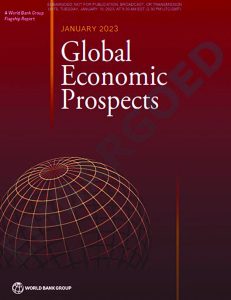Home Top Stories Guyana only country in region to see significant growth rates in 2023,...
A January 2023 report by the World Bank, titled Global Economic Prospects, has indicated that Guyana would again experience significant growth rates for this year and the following year – being the only country in the Latin American and Caribbean region to achieve this.
The new report indicates that growth in the Caribbean is expected to slow to 5.6 percent in 2023 and 5.7 percent in 2024, from 7.7 per cent last year. In the country forecast, Guyana is projected to see a growth rate of some 25.2 per cent for 2023. It is also projected that this expansion would continue in 2024 at 21.2 per cent.
While Guyana will be on the cusp of greater development, other countries in Latin America and the Caribbean would face ‘renewed headwinds’.
“Though 2022 saw resurgent tourism, a sharp downturn in advanced economy growth is likely to slow the recovery. Tighter financing conditions will squeeze investment and make it harder for many islands to roll over debt and finance large fiscal and current account deficits,” the report has stated.
Among the Caribbean’s larger economies, growth in the Dominican Republic is expected to average a solid 4.9 percent in 2023 and 2024. In contrast, Haiti’s economy is expected to contract for the fifth consecutive year in 2023. It remains beset by violence and instability, with nearly one-in-five children chronically malnourished.
Latin America and the Caribbean (LAC) is estimated to have grown 3.6 percent in 2022. Robust expansion in the first half of the year was driven mostly by consumption, supported by recovering labour markets. However, activity weakened late last year, as slowing global growth and tighter financial conditions started to take effect.
“Inflation surged in 2022, reaching multi-decade highs in many countries, with price pressures broadening to a wide array of goods and services. Food prices rose particularly rapidly. Headline inflation appeared to peak in the middle of the year in most countries, but it remains well above central bank targets. Accordingly, central banks continued raising policy rates last year into double digits in the region’s largest economies.”
The World Bank has projected that growth in the region is expected to decelerate sharply to 1.3 percent in 2023, before recovering somewhat to 2.4 percent in 2024. The slowdown reflects efforts by monetary authorities to tame inflation, and spillovers from a weak global outlook.
“Slow global growth is expected to weigh on commodity prices, weakening South America’s terms of trade. Regional investment is expected to decline this year, dampened by higher financing costs, soft business confidence, and elevated policy uncertainty,” the report mentioned.
Brazil is projected to grow 0.8 percent in 2023, as high interest rates curb investment and export growth slows. Mexico’s economy is expected to expand 0.9 percent this year, as restrictive monetary conditions, stubbornly high inflation, and softer exports curtail activity. GDP in Argentina is forecast to grow two percent in 2023, as very high inflation stymies economic activity.
After surging last year, growth in Colombia is also set to slow markedly to 1.3 percent this year. Chile’s economy is likely to contract over the year, as lower real incomes erode consumption. In Peru, elevated policy uncertainty and declining metal prices are expected to dampen growth, forecasted at 2.6 percent in 2023.
Growth in Central America is forecasted to soften to 3.2 percent in 2023, as deceleration in the United States economy hampers exports and inward remittances. The Caribbean is expected to see firmer expansion, at 5.6 percent, but this partly reflects a long-delayed recovery from the pandemic-induced recession.
In identifying the risks, the World Bank noted that weaker-than-anticipated global growth could weigh heavily on commodity prices, undermining economic activity in the region’s commodity exporters. Further tightening of global financial conditions could also lead to financial stress in the region’s more vulnerable economies. (G12)
